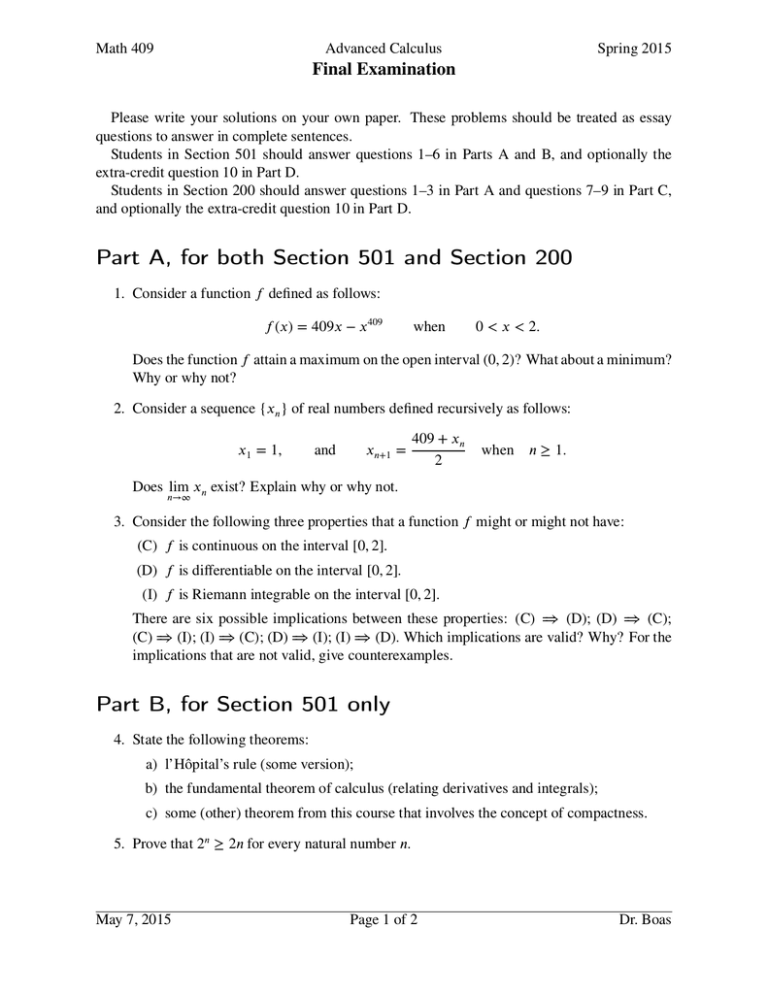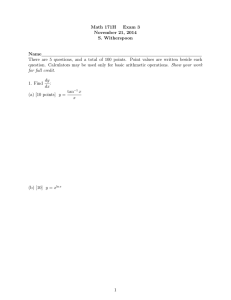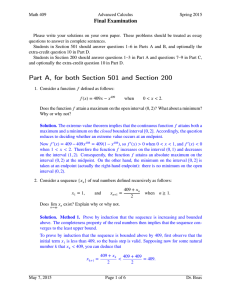Final Examination
advertisement

Math 409
Advanced Calculus
Spring 2015
Final Examination
Please write your solutions on your own paper. These problems should be treated as essay
questions to answer in complete sentences.
Students in Section 501 should answer questions 1–6 in Parts A and B, and optionally the
extra-credit question 10 in Part D.
Students in Section 200 should answer questions 1–3 in Part A and questions 7–9 in Part C,
and optionally the extra-credit question 10 in Part D.
Part A, for both Section 501 and Section 200
1. Consider a function 𝑓 defined as follows:
𝑓 (𝑥) = 409𝑥 − 𝑥409
when
0 < 𝑥 < 2.
Does the function 𝑓 attain a maximum on the open interval (0, 2)? What about a minimum?
Why or why not?
2. Consider a sequence {𝑥𝑛 } of real numbers defined recursively as follows:
𝑥1 = 1,
𝑥𝑛+1 =
and
409 + 𝑥𝑛
2
when 𝑛 ≥ 1.
Does lim 𝑥𝑛 exist? Explain why or why not.
𝑛→∞
3. Consider the following three properties that a function 𝑓 might or might not have:
(C) 𝑓 is continuous on the interval [0, 2].
(D) 𝑓 is differentiable on the interval [0, 2].
(I) 𝑓 is Riemann integrable on the interval [0, 2].
There are six possible implications between these properties: (C) ⇐⇒ (D); (D) ⇐⇒ (C);
(C) ⇐⇒ (I); (I) ⇐⇒ (C); (D) ⇐⇒ (I); (I) ⇐⇒ (D). Which implications are valid? Why? For the
implications that are not valid, give counterexamples.
Part B, for Section 501 only
4. State the following theorems:
a) l’Hôpital’s rule (some version);
b) the fundamental theorem of calculus (relating derivatives and integrals);
c) some (other) theorem from this course that involves the concept of compactness.
5. Prove that 2𝑛 ≥ 2𝑛 for every natural number 𝑛.
May 7, 2015
Page 1 of 2
Dr. Boas
Math 409
Advanced Calculus
Spring 2015
Final Examination
6. Give an example of a continuous function 𝑓 ∶ ℝ → ℝ such that lim 𝑓 (𝑥) = 0, yet
𝑥→∞
𝑥
lim
𝑥→∞ ∫1
𝑓 (𝑡) 𝑑𝑡 = ∞.
Part C, for Section 200 only
7. State the following theorems:
a) some theorem from this course named after a European mathematician whose name
begins with the letter “C”;
b) some (other) theorem from this course that involves the concept of a covering by open
sets or by closed sets;
c) some (other) theorem from this course that involves the intermediate-value property
(Darboux property).
8. Prove that 2𝑛 ≥ 𝑛2 for every natural number 𝑛 larger than 3.
9. Give an example of a bounded function 𝑓 on the interval [0, 1] such that lim 𝑓 (𝑥) does not
𝑥→0+
1
exist, yet lim
𝑥→0+ ∫𝑥
𝑓 (𝑡) 𝑑𝑡 does exist.
Part D, optional extra-credit question for both Section
200 and Section 501
10. Write an essay on the following topic: What is the most important concept or principle or
theorem from this course? Why?
May 7, 2015
Page 2 of 2
Dr. Boas










